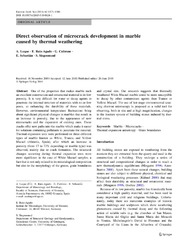Direct observation of microcrack development in marble caused by thermal weathering
Zeitschrift: Environmental Earth Sciences, 201062, 7: 1375 - 1386
DOI: https://doi.org/10.1007/s12665-010-0624-1
Persistent URL: http://resolver.sub.uni-goettingen.de/purl?gldocs-11858/7042
Persistent URL: http://resolver.sub.uni-goettingen.de/purl?gldocs-11858/7042
Luque, A.; Ruiz-Agudo, E.; Cultrone, G.; Sebastián, E.; Siegesmund, S., 2010: Direct observation of microcrack development in marble caused by thermal weathering. In: Environmental Earth Sciences, Band 62, 7: 1375 - 1386, DOI: 10.1007/s12665-010-0624-1.
 |
Dokument öffnen: |
One of the properties that makes marble such an excellent construction and ornamental material is its low porosity. It is very difficult for water or decay agents to penetrate the internal structure of materials with no or few pores, so enhancing the durability of these materials. However, environmental temperature fluctuations bring about significant physical changes in marbles that result in an increase in porosity, due to the appearance of new microcracks and the expansion of existing ones. These cracks offer new paths into the marble which make it easier for solutions containing pollutants to penetrate the material. Thermal expansion tests were performed on three different types of marble known as White, Tranco, and Yellow Macael (Almeria, Spain), after which an increase in porosity (from 17 to 73% depending on marble type) was observed, mainly due to crack formation. The structural changes occurring during thermal expansion tests were more significant in the case of White Macael samples, a fact that is not only related to its mineralogical composition but also to the morphology of the grains, grain boundaries and crystal size. Our research suggests that thermally weathered White Macael marble could be more susceptible to decay by other contaminant agents than Tranco or Yellow Macael. The use of hot-stage environmental scanning electron microscopy is proposed as a valid tool for observing, both in situ and at high magnification, changes in the fracture system of building stones induced by thermal stress.
Statistik:
ZugriffsstatistikSammlung:
- Geologie [930]

